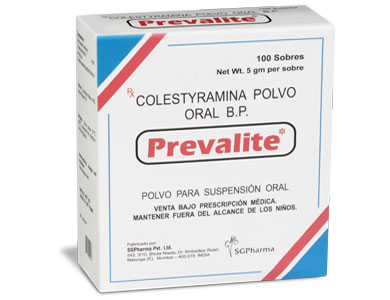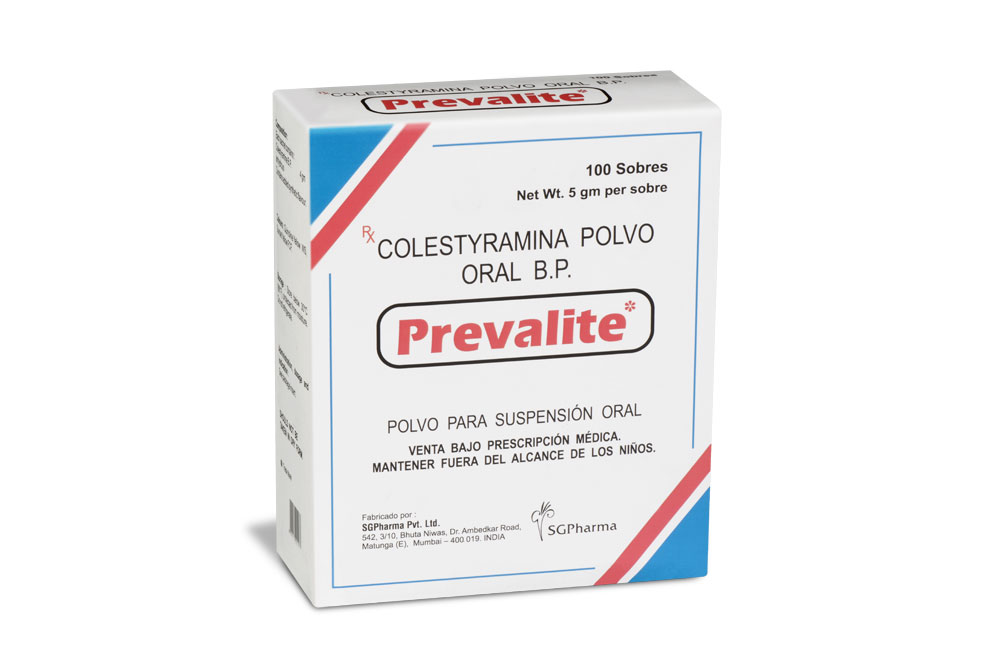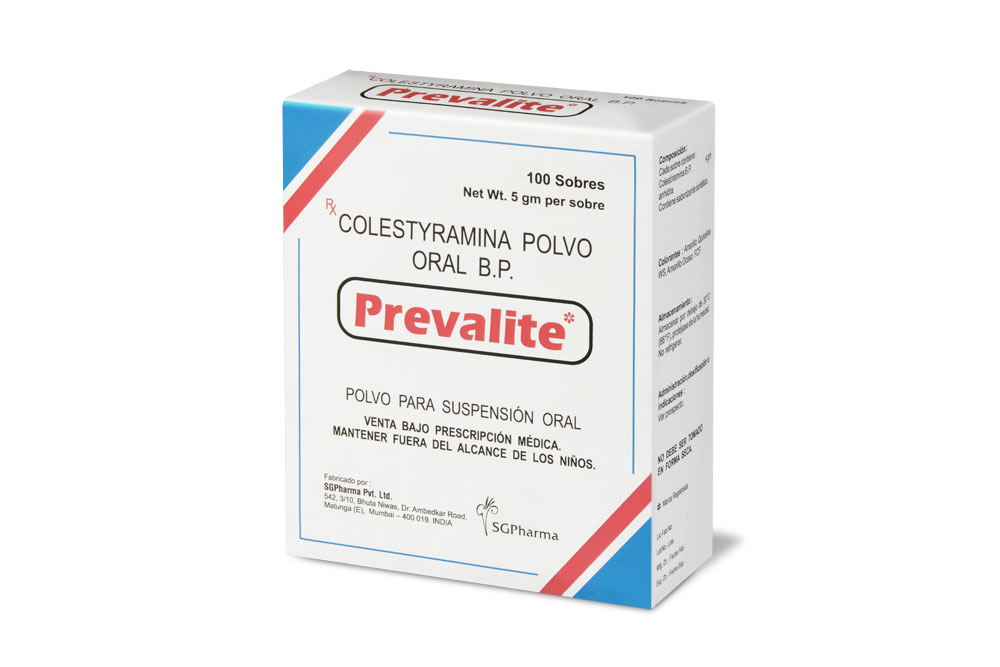
4 gm, 9 gm
For the use of a Registered Medical Practitioner or a Hospital or a Institution only.
PREVALITE (Colestyramine), the chloride salt of a basic anion exchange resin, is a cholesterol lowering agent intended for oral administration.
STRUCTURAL FORMULA :
Its structural formula is :
-Structure.jpg)
PREVALITE is a buff coloured fine powder with a tangy orange flavour.
COMPOSITION :
Each sachet contains :
Colestyramine B.P. 4 gm
anhydrous
Contains added synthetic flavour.
Colours : Quinoline Yellow WS, Sunset Yellow FCF.
ACTIONS :
Colestyramine is the chloride salt of a basic anion-exchange resin, colestyramine. Colestyramine is very hydrophilic, but it is not soluble in water, nor is it hydrolysed by digestive enzymes. Thus, colestyramine is not absorbed from the intestinal tract. Colestyramine resin adsorbs and combines with the bile acids in the intestine to form an insoluble complex which is excreted in the faeces. The increased faecal loss of bile acids leads to an increased oxidation of cholesterol to bile acids and a decrease in serum cholesterol levels and low density lipoprotein cholesterol serum levels. When administered properly, colestyramine usually leads to a significant reduction (15 % or more) in serum cholesterol levels. In patients with pruritis associated with partial biliary obstruction the reduction of serum bile acid levels by colestyramine is thought to reduce excess bile acids deposited in the dermal tissues and promote their excretion with the faeces. The relief from itching afforded to most of these patients by colestyramine is attributed to this mobilisation. It is postulated that in “bile-salt” diarrhoea, colestyramine binds conjugated dihydroxy bile salts which are known to have cathartic effect.
PHARMACOKINETICS :
Colestyramine is not absorbed from the gastrointestinal tract.
INDICATIONS :
For reduction of serum cholesterol and low density cholesterol, lipoprotein levels in primary hypercholesterolaemia in conjunction with an appropriate diet. PREVALITE is indicated as adjunctive therapy to diet for the reduction of elevated serum cholesterol in patients with primary hypercholesterolaemia (elevated low density lipoproteins) who do not respond adequately to diet. PREVALITE may be useful to lower elevated cholesterol that occurs in patients with combined hypercholesterolaemia and hypertriglyceridaemia, but it is not indicated where hypertriglyceridaemia is the abnormality of most concern. For the reduction of pruritus associated with partial biliary obstruction e.g. as in cholestatic jaundice. For the treatment of diarrhoea due to bile acid malabsorption.
Administration :
PREVALITE should not be taken in its dry form. It should be mixed with water or other fluids before ingesting.
Dosage :
Hypercholesterolaemia and hyperlipoproteinaemia may be manifestations of altered metabolism resulting from either dietary excesses or diseases such as hypothyroidism, diabetes, nephrosis, pancreatitis or biliary cirrhosis. The primary objective of therapy should be to control any underlying disease. Proper diet and weight control in these patients is also essential.
Adults :
To reduce cholesterol :
Begin with one 4 gm sachet once or twice daily. The dose can be increased to 8 gm in the morning and in the evening. If necessary, medication may be increased to the maximum of 24 gm of colestyramine resin per day. It is recommended that increases in dose be gradual. If dose increases are necessary, they should be done gradually, and with periodic assessment of lipid/lipoprotein levels at intervals of not less than 4 weeks. The suggested time of administration is mealtime, but this may be modified to avoid interference with absorption of other medications. Although the recommended dosing schedule is twice daily, PREVALITE may be administered in 1-4 doses per day. No more than 24 gm of the active ingredient a day should be administered as larger doses of PREVALITE may interfere with normal fat absorption.
To relieve pruritus due to partial biliary obstruction :
4 gm or 8 gm daily.
To relieve diarrhoea induced by bile acid malabsorption :
The initial dosage of PREVALITE should be 4 gm three times a day, with subsequent adjustment as needed.
NOTE :
IN ALL PATIENTS PRESENTING WITH A DIARRHOEA INDUCED BY BILE ACID MALABSORPTION, A RESPONSE SHOULD BE SEEN WITHIN 3 DAYS. IF THIS IS NOT THE CASE, ALTERNATE THERAPY SHOULD BE INITIATED. To familiarize the patient with PREVALITE and to minimise gastrointestinal side-effects, it is desirable to begin all therapy with one dose of PREVALITE daily. The dosage is then increased within a day or two to the starting dose for effective control.
NOTE :
PREVALITE SHOULD NOT BE TAKEN IN ITS DRY FORM. ALWAYS ADMIX PREVALITE WITH WATER OR OTHER FLUIDS BEFORE INGESTING.
Children :
The precise dosage for children has not yet been established.
Preparation :
Place the contents of a 5 gm sachet PREVALITE on the surface of 115-170 ml of water or beverage, such as milk, fruit juice or broth. Use more water or beverage for the two sachets (200-300 ml). Stir to a uniform suspension. PREVALITE may also be used with pulpy fruits, such as apple sauce or crushed pineapple. NEVER INGEST PREVALITE IN ITS DRY FORM.
CONTRAINDICATIONS :
PREVALITE is contra-indicated in patients with complete biliary obstruction and in those individuals who have shown hypersensitivity to any of its components. The safety in pregnancy and lactation has not been established.
PRECAUTIONS :
General
Before instituting therapy with PREVALITE, diseases contributing to increased blood cholesterol such as hypothyroidism, diabetes mellitus, nephrotic syndrome, dysproteinemias and obstructive liver disease should be looked for and specifically treated. In addition, prior to instituting therapy with PREVALITE, an attempt should be made to control serum cholesterol by appropriate dietary regimen, weight reduction and the treatment of any underlying disorder which might be the cause of the hypercholsterolemia. Serum cholesterol levels should be determined frequently during the first few months of therapy and periodically thereafter. A favourable trend in cholesterol reduction should occur during the first month of PREVALITE therapy. The therapy should be continued to sustain cholesterol reduction. Serum triglyceride levels should be measured periodically to detect whether significant changes have occurred.
IF ADEQUATE CHOLESTEROL REDUCTION IS NOT ATTAINED, THERAPY WITH PREVALITE SHOULD BE DISCONTINUED. There is a possibility that prolonged use of PREVALITE in high doses may produce hyperchloraemic acidosis, since it is the chloride form of an anion exchange resin. This is especially true in younger and smaller patients where the relative dosage may be higher. Colestyramine resin may produce or aggravate pre-existing constipation or related conditions such as haemorrhoids. In patient with constipation, the dosage of colestyramine resin should be decreased, since it may produce impaction. In patients presenting with clinically symptomatic coronary artery disease, where straining of the stool is to be avoided, the dosage of coronary artery disease, where straining of the stool is to be avoided, the dosage of PREVALITE should be titrated to avert constipation.
Chronic use of colestyramine resin may be associated with increased bleeding tendency due to hypoprothrombinemia associated with vitamin K deficiency. This will usually respond promptly to parenteral vitamin K administration; recurrences can be prevented by oral administration of vitamin K. Reduction of serum or red cell folate has been reported and treatment with folic acid should be considered in this cases. PREVALITE should be used with caution in patients with peptic ulcers or with a history of peptic ulcer disease as it might aggravate or activate this condition.
Oral Rehydration Therapy
In patients with diarrhoea, fluid and electrolyte depletion may occur. Administration of appropriate fluid and electrolyte replacement is the most important measure.
Pregnancy :
Since PREVALITE is not absorbed systemically, it is not expected to cause foetal harm when administered during pregnancy in recommended dosages. There are no adequate and well controlled studies in pregnant women, and the known interference with absorption of fat soluble vitamins may be detrimental even in the presence of supplementation
Nursing mothers :
Caution should be exercised when PREVALITE is administered to nursing mother. The possible lack of proper vitamin absorption by mothers described in the “Pregnancy” section may have an effect on nursing infants.
DRUG INTERACTIONS :
SINCE PREVALITE MAY BIND OTHER MEDICINES GIVEN CONCURRENTLY, PATIENTS SHOULD TAKE OTHER MEDICINE AT LEAST ONE HOUR BEFORE OR 4-6 HOURS AFTER PREVALITE TO AVOID IMPEDING THEIR ABSORPTION, OR ATAS GREAT AN INTERVAL AS POSSIBLE. Since colestyramine is an anion-exchange resin, PREVALITE has a strong affinity for acidic material. PREVALITE may delay or reduce the absorption of concomitant oral medication such as phenylbutazone, warfarin, chlorothiazide (acidic), or propranolol as well as tetracycline, penicillin G, phenobarbital, aspirin, thyroid and thyroxine preparations, and digitalis. The discontinuance of PREVALITE could pose a hazard to health if a potentially toxic medicine such as digitalis has been titrated to a maintenance level while the patient was taking PREVALITE. Also, PREVALITE may interfere with the pharmacokinetics of medicines (e.g., estrogens) that undergo enterohepatic recirculation.
Absorption of fat soluble vitamins :
Because it sequesters bile acids, PREVALITE may interfere with normal fat absorption. PREVALITE may prevent absorption of fat-soluble vitamins, such as vitamins A, D and K. Therefore when PREVALITE is to be given for long periods, daily water miscible or Parenteral supplements of vitamins A, D and K should be considered.
SIDE EFFECTS :
The most common adverse reaction is constipation. Predisposing factors for most of these complaints when PREVALITE is used as a cholesterol lowering agents are high dose and increased age (more than 60 years old). Most instances of constipation are mild, transient and controlled with conventional therapy. Some patients require a temporary decrease in dosage or discontinuation of therapy.
Less Frequency Adverse Events :
Abdominal discomfort, flatulence, nausea, vomiting, diarrhoea, heartburn, anorexia, dyspepsia and steatorrhoea, bleeding tendencies due to hypoprothrombinemia (Vitamin K deficiency) as well as Vitamin A (night blindness has been reported) and D deficiencies, hyperchloraemic acidosis in children, and osteoporosis. Rash and irritation of skin, tongue and perianal area. Reports of intestinal obstruction have been received post marketing, including two deaths in paediatric patients. Calcified material has occasionally been observed in the biliary tree, including calcification of gall-bladder, in patients to whom colestyramine resin has been given. However, this may be a manifestation of the liver disease and not drug related . One patient experienced biliary colic on each of three occasions on which he took colestyramine. One patients diagnosed as acute abdominal symptom complex was found to have a ‘pasty mass’ in the transverse colon X-ray.
Other events (not necessarily drug related) reported in patients taking PREVALITE includes :
Gastrointestinal : GI-rectal bleeding, black stools, haemorrhoidal bleeding, bleeding from known duodenal ulcer, dysphagia, hiccups, ulcer attack, sour taste, pancreatitis, rectal pain, diverticulitis eructation.
Laboratory Test Changes : Liver function abnormalities.
Haematologic : Decreased or increased prothrombin time, ecchymoses, anaemia.
Hypersensitivity : Urticaria, asthma ,wheezing, shortness of breath.
Musculoskeletal : Backache, muscle and joint pains, arthritis.
Neurologic : Headache, anxiety, vertigo, dizziness, fatigue, tinnitus, syncope, drowsiness, femoral nerve pain ,paresthesia.
Eye : Uveitis.
Renal : Haematuria, dysuria, burnt odour to urine, diuresis. Miscellaneous - Weight loss, weight gain, increased libido, swollen glands, oedema, dental bleeding, dental caries.
OVERDOSAGE :
One case of overdosage with PREVALITE has been reported in a patient taking 150 % of the maximum recommended daily dosage for several weeks. No ill effects were observed.
TREATMENT OF OVERDOSAGE :
Should overdosage occur, the chief potential harm would be obstruction of the gastrointestinal tract. The location of such potential obstruction, the degree of obstruction and the presence or absence of normal gut motility would determine treatment.
STORAGE :
Store below 30°C (86°F), protected from moisture.
Do not refrigerate.
SHELF LIFE :
24 months from the date of manufacture.
PRESENTATION :
Each 5 gm aluminium sachet contains 4 gm Colestyramine B.P.
100 sachets are packed in a box.
Disclaimer : For the use of a Registered Medical Practitioner or a Hospital or a Institution only. Also it is not intended to be used by healthcare professionals or patients for the purpose of prescribing or administering these products. Questions regarding the complete and current content of product labeling / specification / presentation should be directed to SGPharma.

 Cardiovascular
Cardiovascular






